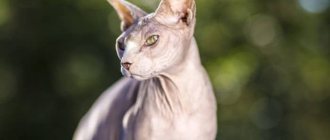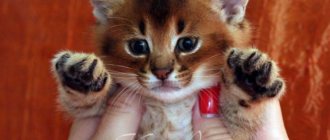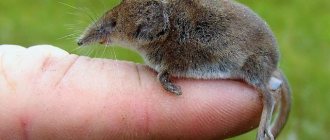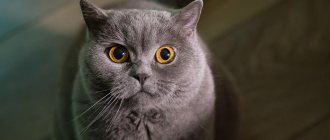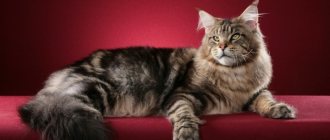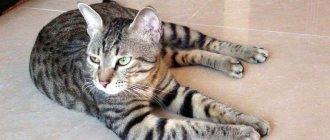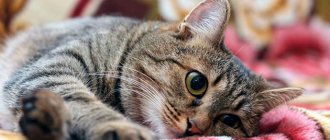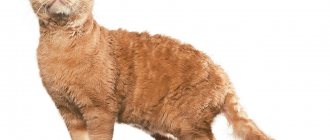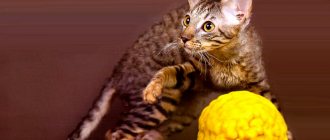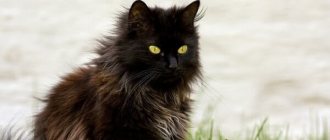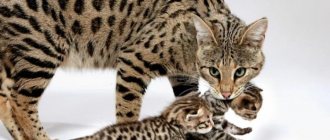History of the origin of the breed
This cat is of Russian origin. Its first representatives appeared in St. Petersburg, bred by felinologists Olga Mironova and Tatyana Komarova by crossing two well-known lines - the Don Sphynx and the Oriental.
The ancestor of the St. Petersburg Scythians is the oriental female Radma Von Jagenhorff, the father is the male Don Sphynx Afinogenes Myth. In the first two litters we managed to get four original kittens - Mandarin, Muscat, Nezhenka, Nocturne.
The breed owes its lack of hair to the Scythian, the shape of the head and body, as well as the Asian character - the Oriental.
Bald Pepper literally translates to “bald Peter.” This name arose thanks to the humorous name of one of the statues of Peter the Great in the northern capital, where the ruler is depicted with his head not covered with a wig.
The Neva Sphinx was immediately accepted by international felinology. In 1996 it was registered with the Breeding Feline Federation (SFF), in 1997 - with The International Cat Association (TICA), in 2003 with the World Cat Federation (WCF).
Breed standard
According to the TICA system classification, the Peterbald has the following description:
- Head. Triangular in shape, large in relation to the body, long, with flat cheekbones and a pointed chin. Two planes - a straight nose and a flat forehead.
- Nose. Long, straight and wide, with a “proud, eagle-like profile.”
- Mustache and eyebrows. Absent or thin, curly, broken.
- Neck. Long, graceful, narrow.
- Ears. Very large, widely spaced, protruding beyond the cheek line. With a wide base and sharp tips.
- Eyes. Medium size, round, slightly elongated. Normal convexity. Quite widely spaced - the distance between them is equal to the width of one eye. Eye color can be deep blue, bright blue, green, regardless of the pattern and shade of the skin.
- Body. Long, graceful, muscular, lean, the width of the body is the same along the entire length from the shoulders to the hips.
- Paws. Medium length, muscular, dry, slender. The hind ones are slightly longer than the front ones. The foot is elongated with rounded pads and toes.
- Tail. Muscular, agile, proportional to the body.
- Dimensions. Small ones. The female weighs about three, the male no more than four kilograms.
- Color. The skin is mobile, elastic, with folds, soft and velvety to the touch. The textures of the coat are varied, which is unique to this breed - from completely bald individuals to completely covered with hair. Acceptable colors are color point, blue, lilac, chocolate, particolor, cream.
- Crossbreeding. Allowed with Don Sphynx, Oriental and Siamese breeds.
Flaws:
- break (bend) on the bridge of the nose;
- structural defects of the skull and muzzle;
- small, weak chin;
- heavy, round body;
- severe curvature of the front paws.
Disqualification:
- defects, tail breaks;
- keel-shaped protruding chest;
- strabismus;
- aggressive behavior;
- traces of artificial hair removal.
Coat Variations
Only the Peterbald has such a variety of skin and coat varieties. In one litter, kittens of absolutely all types can be born:
- Brush. They are born with little fur. As they grow older, the fur disappears in some areas, while the rest are evenly covered with hair.
- Brush point. At birth, the kitten is covered with thicker hair, the muzzle and tail are completely pubescent. In an adult animal, fur remains on some parts of the head, paws and tail. The rest of the body is covered with a delicate short flock.
- Velours. At birth, a kitten has long hair on its face, paws, and tail. Later, very short hair remains in these areas, the rest of the body is naked.
- Flock. The newborn has no eyebrows or mustache. Light fur all over the body can be determined only by touch, not visually visible, the hair length is up to two millimeters. An adult cat is completely hairless; there may be some sensation of fur on the hands.
- Straight-haired. Full coat, characteristic of the Oriental, there is no hairless gene. In terms of body structure and habits - Peterbald.
- Rubber (bald-born). It is very rare that babies are born completely bald, both visually and to the touch. In an adult cat by the age of two, the skin feels like rubber, stretches well, the skin is velvety and soft to the touch.
It is not always possible to determine the type of integument immediately at birth. More often this can be done in five to seven days.
The type indicator can be the period of eye opening. The Peterbald has a special structure of the lacrimal glands, which allows rubber sphinxes to be born with open eyes without the threat of loss of vision. Brush, point brush and velor open their eyes on the fifth day after birth.
The most valued and recommended for show class are bald and flock-Peterbalds, as they are animals with the most pronounced characteristics of the breed.
Temperament of the St. Petersburg Sphynx
For those people who are thinking about purchasing a Neva Sphynx, it would be useful to understand the features of this breed:
- Experts often call this animal a “cat-dog”, since its habits are more reminiscent of a dog’s - they follow their owner with their “tail”, are able to learn the simplest commands, are smart and amenable to training.
- They are loving towards all family members and do not tolerate loneliness well.
- They are affectionate, capable of waiting for the owner all day, sitting at the door and joyfully rushing towards him. They know their name well and respond.
- Talkative too much. If you love a calm, measured life, then it is unlikely to be possible with the St. Petersburg Sphynx. The cat almost always “talks”, expressing all his feelings and emotions.
- Since the Peterbald cannot be left alone at all, you will have to find him a playmate, and he will get along with absolutely any pet.
- They are very playful all their lives and are happy to join children in noisy fun.
- Smart and cunning. They easily learn to open everything - bags, drawers, doors to the room, and even the refrigerator.
- They are unusually voracious, which is due to their physiological characteristics.
- Clean, excellent hunters.
When choosing this pet, you need to remember that you won’t be bored with it and balance your habits and inclinations with the cat’s temperament.
Peterbald character
In some publications you can read an original review of the St. Petersburg sphinxes, which characterizes them as accurately as possible:
“In the morning he will wake you up, during the day he will get bored, in the evening he will greet you and caress you, he eats something all day and constantly plays.”
Such a cutie cannot have an evil character, these are sugar-sweet creatures. Sphinxes are sociable animals; they can be friends with all the inhabitants of the house, except their owner. Because you don’t need to be friends with him, but you need to love him. Loyal animals with a soft, flexible character. They love to play with the ball, climb on supports, and rush around the house.
Peterbalds have one peculiarity - they constantly talk. Even at night, their “purring” mode does not turn off. The radio is about St. Petersburg Sphynxes, so this nuance should be taken into account by those who want to get a pet of this breed.
Eastern roots make themselves felt in the behavior of sphinxes - they will follow their owner like a dog all day long, trying to cuddle and attract attention to themselves. They also got a hoarse voice, the tone of which can change depending on the animal’s mood. Melodious purring and hoarse meows play in all possible ranges.
Constant contact with people is so characteristic of Peterbalds. They love warmth and comfort; at night they can crawl under the covers and lie down next to their owner. They love to be petted, talked to, caressed, scratched. Unlike the Oriental cat, which is the ancestor of the breed, Peterbalds are not touchy and you should not look for a secret meaning in their behavior - they are the most sincere creatures.
Perhaps their most obvious drawback is loneliness, which can make a cat deeply unhappy and broken. Therefore, do not neglect the company of this wonderful and charming beauty. Pamper them with your attention, love, care.
St. Petersburg Sphynxes are very trainable and if you are not too lazy and put in a little effort, they are so smart that they can follow commands. For example, how dogs fetch an object, which can then be turned into an interesting game for the cat. They easily master the toilet and quickly get used to the tray, they are very clean.
Care and nutrition
The Neva Sphynx has no hair, but caring for your pet's skin is no less important. The skin of the animal secretes a special secretion, the role of which is to lubricate the folds and prevent drying and peeling. Bathing with zoo shampoo is necessary at least twice a week. After water procedures, you should dry your skin well to prevent hypothermia.
Like any cat, representatives of this breed love to bask in the sun. You need to carefully monitor their health to avoid burns and overheating.
In adult cats, the lacrimal glands continue to work intensively, so enhanced daily eye care is required using special lotions and herbal decoctions.
Ears, like those of any cat, are recommended to be cleaned at least once a week.
Nails should be trimmed to prevent accidental injury to the skin by unprotected fur during play.
St. Petersburg sphinxes need increased nutrition due to the high energy consumption to maintain heat exchange, which is also associated with the lack of hair in these animals. It is necessary to choose a complete and balanced diet - ready-made premium or super-premium dry mixtures, wet food or high-quality natural food.
Caring for St. Petersburg Sphynxes
St. Petersburg Sphynxes require slightly different care than other animals. As you might guess, this is due to the peculiarities of their physiology. Thus, for the St. Petersburg Sphynx, lacrimation is the norm; this manifests itself most intensely during meals, so periodically wipe the skin around the eyes and eyelids with a damp cotton wool or napkin. Hairless skin has an increased production of secretion; it looks like a slightly brown wax that may appear on the skin near the claws or in the ears.
Remember that skin not protected by fur is susceptible to the harmful effects of ultraviolet radiation; in other words, the Peterbald can get sunburned under the bright sun. The Sphynx's skin is prone to chapping and dryness, to avoid this, cosmetic oil is used, often baby oil, as it is hypoallergenic. During the cold season, protect your Peterbald from drafts to avoid colds, especially after bathing your pet.
Another feature of Peterbalds is intense sweating, so weekly bathing is very important for the health of the Petersburg Sphynx. Between baths, wipe it with a damp sponge. Over time, the Peterbald will get used to regular bathing, but until this happens, bathing the cat will not be an easy task; a wet, soapy Peterbald will easily slip out of the owner’s tenacious hands. You should choose products for washing your Peterbald carefully, since his skin is quite sensitive to chemicals. It is better to give preference to baby soap; it is subject to the most stringent requirements for the content of harmful and allergic substances, or purchase cat shampoo for Sphynxes.
Peterbalds' claws are trimmed twice a month. It is also good if your pet has his own scratching post - this, firstly, will allow him to trim his claws less often, and secondly, sharpening his claws improves the animal’s mood, and a happy cat is a healthy cat. To increase life expectancy, your pet needs physical activity. If possible, equipping a “sports” corner for a cat would be the right solution.
Health
This breed has a genetic predisposition to only one disease - ectodermal dysplasia, which can lead to the formation of malocclusion.
Due to increased nutrition, a cat may develop obesity. You should monitor your pet's eating habits, avoiding starvation and overeating. An adult Sphynx needs to be fed at least twice a day, a kitten - up to five times.
These animals are also prone to colds. You should not allow them to become hypothermic, maintain a sufficient temperature in the premises and ensure there are no drafts. During the cold season, special clothing for cats is allowed.
Increased lacrimation requires special attention to your cat's eyes.
Timely deworming and annual vaccination against all known viral infections and rabies will also help maintain normal cat health.
With proper care, the life expectancy of a Peterbald can be twenty years.
Pet diseases
You need to keep an eye on your pet's tan. Short sunbathing will do him good. But everything should be in moderation. Otherwise, the cat will get burned.
In addition, there are other diseases. For example, gum hyperplasia and underdevelopment of the thymus gland may occur (the organ is responsible for the development of the pet’s entire body). Skin and respiratory ailments are common. Average life expectancy is 14 years.
Peterbald - St. Petersburg Sphynx. This breed is distinguished by sophistication and grace. These are charming pets that everyone in the house will love. They also treat people well, as they are friendly and sociable.
Kitten price
It is necessary to purchase a kitten only from professional nurseries at least three months old. A veterinary passport is required. Today, the sale of the St. Petersburg Sphynx is carried out by numerous breeders from different cities of Russia.
The cost of an animal varies widely depending on the purpose of purchase. You can buy a Neva Sphynx as a pet for ten thousand rubles. The price of a pet for professional breeding or exhibition work will be significantly higher.
Photo gallery of Peterbald and some other types of sphinxes:
Mating and choosing a kitten
Since the St. Petersburg Sphynx breed is quite young, such animals are just beginning to gain popularity. In Russia there are only a few nurseries that breed such cats. The average cost of a kitten is from 5 to 15 thousand rubles. Kittens that fully comply with the standard and exhibition norms are more expensive - from 35 to 50 thousand rubles.
Breeders advise taking kittens away from their mother no earlier than 3 months. If you do this earlier, the kitten will have a hard time being separated from its mother, which will negatively affect its health.
Since the Peterbald is a rare breed, difficulties with mating are inevitable. If the owner plans to breed the breed in the future, it is recommended to keep in touch with the breeder, who will help find a good partner. Before mating, the cat must be treated for worms and make sure there are no other diseases.
